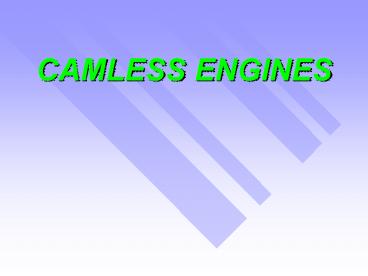CAMLESS ENGINES - PowerPoint PPT Presentation
Title:
CAMLESS ENGINES
Description:
CAMLESS ENGINES Introduction CAMS Control the breathing channels (valves) of an IC engine Connected to camshaft which is operated by crankshaft Cams push open valves ... – PowerPoint PPT presentation
Number of Views:181
Avg rating:3.0/5.0
Title: CAMLESS ENGINES
1
CAMLESS ENGINES
2
Introduction
- CAMS
- Control the breathing channels (valves) of an IC
engine - Connected to camshaft which is operated by
crankshaft - Cams push open valves at proper time guide
their closure - But they are inflexible except VTEC VVT-I
- Engineers could not vary timing, lift duration
of valve opening infinitely
3
- CAMLESS ENGINES
- Eliminated mechanical linkages
- Could provide infinite variation of valve
parameters - It can make engines clean, efficient responsive
4
Working of conventional engines
- The crankshaft turns camshaft which operates
valves by mechanism as in figure - Spring brings back valve to initial position
- Timing of engine valves depends on shape of cams
5
Conventional engine valves
6
- Engineers must design cams in the development
stages - This design compromises b/n engine power fuel
efficiency - Considering this compromise automobile companies
brought variable valve timing mechanisms - But is effects were limited
7
Camless engines overview
- Main sensors -
- Engine load sensor Exhaust gas sensor
- Valve position sensor Engine speed sensor
8
- Sensors sense parameters send signals to ECU
- ECU contains microprocessors with associated
software - This ECU controls the actuators to work according
to requirements
9
Actuators
- It is a electro-hydraulic camless valve train
(ECV) - Uses elastic property of compressed hydraulic
fluid which acts like a liquid spring,
accelerates decelerates the valves
10
- Hydraulic pendulum
- Involves conversion of PE to KE and back to PE
with minimum energy loss - During acceleration of valves PE is converted to
KE - During deceleration of valve energy of moving
valve is returned to fluid
11
Detailed view of Hydraulic Pendulum
12
Operation of hydraulic pendulum
13
(No Transcript)
14
(No Transcript)
15
- Lift, timing duration of valve opening is
varied by controlling solenoid valves - This is done by ECU when signals are sent from
the sensors
16
Modifier Rod
- Used to impart
- Unequal lift to the paired valves
- Zero motion to any valve
17
Modifier Rod Operation
18
(No Transcript)
19
Advantages
- Offers continuously variable independent
control of all aspects of valve motion - lift,
operation duration, event of opening - ECV system can control valve velocity, valve
acceleration and deceleration
20
Resultant Advantages
- Better fuel economy- 7 to 10 increase
- Higher torque power- 10 to 15 increase
- Lower exhaust emissions- EGR system is eliminated
since EGR effect occurs on its own thus reduces
NOx emissions - Reduction in size weight
21
Disadvantages
- Opening closing of valves requires some power-
- Electromechanical- alternator
- Electrohydraulic- accumulator
- Sophisticated electronic control required for
gentle seating of valves - Current solenoids cannot run at high rpms
- Hidden cost of microprocessor software controls
22
Conclusion
- Even though some disadvantages are present, we
can expect electrohydraulic electromechanical
valves to replace the conventional camshaft
technology.
23
Thanks































